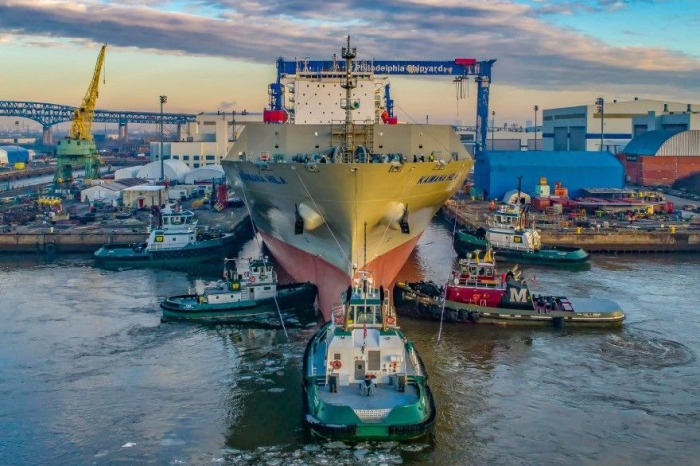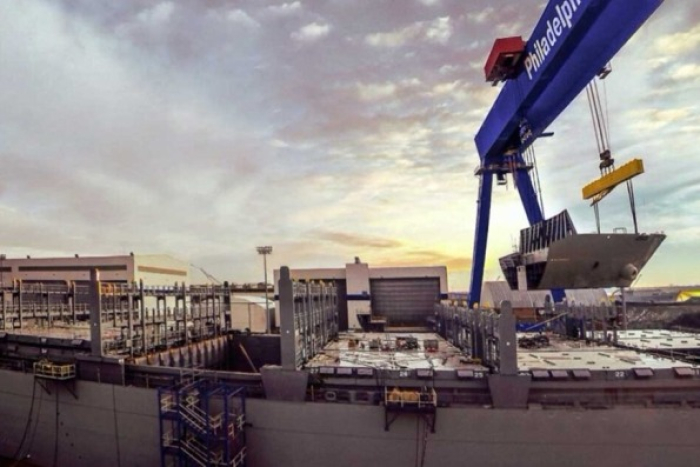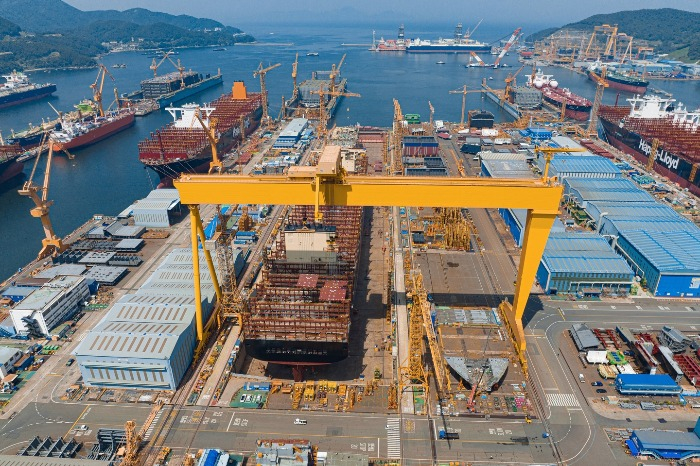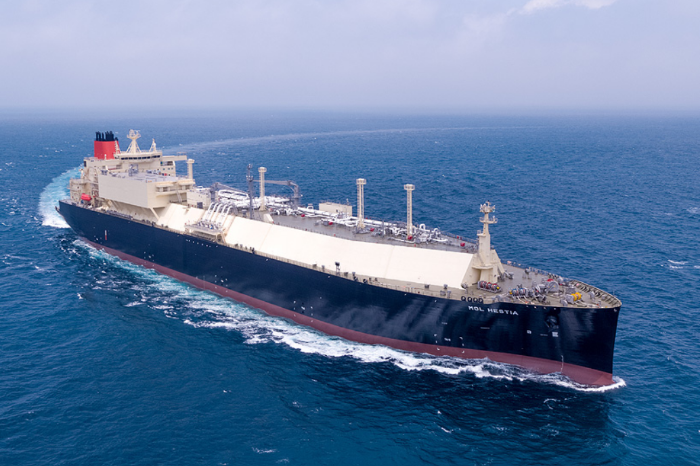Hanwha Philly Shipyard to localize LNG builds, expand capacity
The facility expansion aligns with the Trump administration's push to bring high-value shipbuilding back to the US
By 5 HOURS AGO
In China’s waterway city Hangzhou, K-beauty redefines ‘shuiguang'


When in S. Korea, it’s a ritual: Foreigners make stops at CU, GS25, 7-Eleven


Mubadala, Goldman Sachs to invest $700 mn in Kakao Mobility


Samsung steps up AR race with advanced microdisplay for smart glasses


S.Korea’s mid-tier shipbuilders sail into new supercycle as China struggles



Hanwha Group will significantly increase production capacity at its US shipyard from 1.5 vessels to 10 per year as it aims to transform the facility into a mid-to-large-sized shipbuilder and the first in the US to build liquefied natural gas (LNG) carriers.
In a recent meeting with Korean analysts invited to the shipyard, Hanwha said it will expand Hanwha Philly Shipyard’s revenue by tenfold to $4 billion per year within a decade, fueled by high-value commercial ships and contracts for US Navy logistics support vessels.
The South Korean chemicals-to-defense conglomerate, the operator of Hanwha Ocean Co., acquired it for $100 million last year to make its inroads into the US.
It plans to construct LNG ships at Hanwha Philly Shipyard, which would mark a first for a US-based shipyard. The shipyard currently specializes in 2,600–3,600 twenty-foot equivalent unit (TEU) container ships and crude oil tankers.
It is now undergoing process optimization and facility upgrades to boost output at Dock No. 4 from the current one to four vessels annually.
The yard, which operates Docks 4 and 5 out of its five drydocks, will also reactivate Dock No. 5 currently used only as a quay by refurbishing it for full production.
Industry sources estimate that Hanwha would spend more than 100 billion won ($74 million) on the upgrades, including quay expansion, drydock repairs and automation systems.
“Philly Shipyard plans to boost productivity by addressing key bottlenecks in its operations, including expanding its painting facility to eliminate process delays,” said Choi Kwang-sik, an analyst at Daol Investment & Securities.
Once facility expansion and renovations are completed, the shipyard's annual output is expected to rise to between eight and 10 vessels.

“One of the US government’s top priorities is fostering the domestic construction of high-value vessels such as LNG carriers,” a Hanwha Group official said. “Given Hanwha Ocean’s expertise in LNG shipbuilding, we’re confident we can construct these vessel successfully in the US.”
US shipbuilders have stopped building an LNG vessel since the 1980s, ceding ground to South Korean, Chinese and Japanese firms as technical challenges and high labor costs undercut their competitiveness.
In 2024, Hanwha Philly Shipyard recorded $368 million in revenue. Its sales goal of $4 billion for the next decade represents about half of Hanwha Ocean’s sales of 10.78 trillion won ($7.8 billion) in 2024 and surpasses HD Hyundai Mipo Co.'s 4.63 trillion won.
STRATEGIC SEALIFT FLEET
Philly Shipyard has secured around half of commercial ship orders, mainly for 2,600–3,600 TEU container ships and crude oil tankers, placed under the Johns Act.
The Act requires that goods shipped between US ports be transported on ships built, owned and operated by United States citizens or permanent residents.
Philly Shipyard also stands to benefit from the US sealift fleet expansion. Under a legislative proposal made last month, Washington will expand the US-flagged strategic sealift fleet to 250 vessels.

Hanwha Ocean plans to venture into the shipbuilding block supply market in the US as well,
“Newbuild prices in the US are more than three times higher than in South Korea,” said Daol Investment’s Choi. “Even after factoring in 1.5 times higher labor costs and lower productivity, the conditions remain favorable for generating solid profits.”
TAILORED STRATEGIES FOR SHIP EXPORTS
Meanwhile, the Federation of Korean Industries (FKI) on Monday recommended the Korean government and shipbuilders to adopt vessel-specific strategies to capture emerging opportunities from the US fleet expansion plan, which is expected to generate orders for up to 448 ships by 2037.
The strategies include localizing LNG carrier production in the US; targeting transport, support and amphibious ships for the US Navy’s newbuild programl and easing controls on technology transfer, said the business lobby group. FKI cited a research report commissioned to a national university.
According to the research conducted by Ryu Min Cheol, a professor at Korea Maritime & Ocean University, the US is expected to order between 403 and 448 ships by 2037, including up to 175 naval vessels and 65 LNG carriers.

To facilitate the entry of South Korean shipbuilders into the US, policymakers should consider loosening export controls on shipbuilding technologies, excluding core or sensitive technologies.
South Korea currently require government approval for the overseas transfer of designs and manufacturing know-how in the shipbuilding sector.
Write to Wu-Sub Kim and Yeonhee Kim at duter@hankyung.com
Jennifer Nicholson-Breen edited this article.
-
 Shipping & ShipbuildingS.Korea’s mid-tier shipbuilders sail into new supercycle as China struggles
Shipping & ShipbuildingS.Korea’s mid-tier shipbuilders sail into new supercycle as China strugglesMay 13, 2025 (Gmt+09:00)
4 Min read -
 Shipping & ShipbuildingWith domestic dockyards fully booked, Korean shipbuilders turn overseas
Shipping & ShipbuildingWith domestic dockyards fully booked, Korean shipbuilders turn overseasApr 14, 2025 (Gmt+09:00)
4 Min read -
 Shipping & ShipbuildingS.Korean shipbuilders rally as Trump hints at buying foreign ships
Shipping & ShipbuildingS.Korean shipbuilders rally as Trump hints at buying foreign shipsApr 11, 2025 (Gmt+09:00)
2 Min read -
 Shipping & ShipbuildingHD Hyundai Heavy, HII team up for naval shipbuilding
Shipping & ShipbuildingHD Hyundai Heavy, HII team up for naval shipbuildingApr 09, 2025 (Gmt+09:00)
4 Min read -
 EnergyAlaska governor seeks Korean partners for $44 bn LNG project
EnergyAlaska governor seeks Korean partners for $44 bn LNG projectMar 25, 2025 (Gmt+09:00)
2 Min read -
 Shipping & ShipbuildingKorea’s Hanwha Ocean sends USNS Wally Schirra back to theater after MRO
Shipping & ShipbuildingKorea’s Hanwha Ocean sends USNS Wally Schirra back to theater after MROMar 14, 2025 (Gmt+09:00)
5 Min read -
 Shipping & ShipbuildingKorean shipbuilders to benefit from rising LNG, oil tanker demand
Shipping & ShipbuildingKorean shipbuilders to benefit from rising LNG, oil tanker demandFeb 17, 2025 (Gmt+09:00)
2 Min read -
 Shipping & ShipbuildingHanwha to more than double staff at US Philly Shipyard in 10 years
Shipping & ShipbuildingHanwha to more than double staff at US Philly Shipyard in 10 yearsJan 07, 2025 (Gmt+09:00)
1 Min read -
 Shipping & ShipbuildingHanwha completes acquisition $100 mn Philly Shipyard
Shipping & ShipbuildingHanwha completes acquisition $100 mn Philly ShipyardDec 20, 2024 (Gmt+09:00)
1 Min read -
 Shipping & ShipbuildingHanwha Ocean, HD Hyundai reconcile, look to joint overseas warship bids
Shipping & ShipbuildingHanwha Ocean, HD Hyundai reconcile, look to joint overseas warship bidsNov 24, 2024 (Gmt+09:00)
3 Min read -
 EnergyS.Korean firms bet big on US LNG market under new Trump gov't
EnergyS.Korean firms bet big on US LNG market under new Trump gov'tNov 20, 2024 (Gmt+09:00)
2 Min read -
 Aerospace & DefenseKorea’s Hanwha wins US Navy MRO deal as Trump seeks deeper shipbuilding ties
Aerospace & DefenseKorea’s Hanwha wins US Navy MRO deal as Trump seeks deeper shipbuilding tiesNov 12, 2024 (Gmt+09:00)
3 Min read


